RECENT BLOG NEWS
wolfSSL Performance on Intel x86_64 (Part 4)
Recent releases of wolfSSL have included new assembly code targeted at the Intel x86_64 platform. Large performance gains have been made and are being discussed over six blog posts of which this is part 4. In this blog, we will talk about the performance of Curve25519 and Ed25519.
Curve25519 is set of parameters for a Montgomery elliptic curve and has ~128-bit security. It is used in key exchange and has become popular due to its speed and inclusion in standards. The algorithm is included as part of TLS v1.3 and NIST is considering it as part of SP 800-186. Ed25519 is set of parameters for a Twisted Edwards curve and is mathematically related to Curve25519 and has the same security properties. A new signature scheme has been designed over Twisted Edwards curves that is fast and included as part of TLS v1.3. A draft specification has been written describing digital certificates using EdDSA with Ed25519.
In a TLS handshake, a key exchange operation should always be performed to ensure forward-secrecy. When used, it will be a significant amount of the processing time during the handshake. Improving the performance of Curve25519, therefore, increases the number of TLS connections that can be made per second.
Older releases of wolfSSL have a C implementation of the algorithms. While the C code was quite fast, the new assembly code is significantly better. There is assembly code for generic Intel x86_64 CPUs, and for CPUs with BMI2 and ADX (Broadwell and newer CPUs).
The two charts below show the relative performance of wolfSSL and OpenSSL compared to the C implementation on Ivy Bridge and Skylake CPUs. On the Ivy Bridge CPU, the new assembly code is between 20% and 60% better than the C code and is better than OpenSSL in the one operation that can be measured. On the Skylake CPU, the assembly code is between 60% and 86% faster. The OpenSSL code has not been optimized for this CPU and is significantly slower.
Contact us at support@wolfssl.com with questions about the performance of the wolfSSL embedded TLS library.
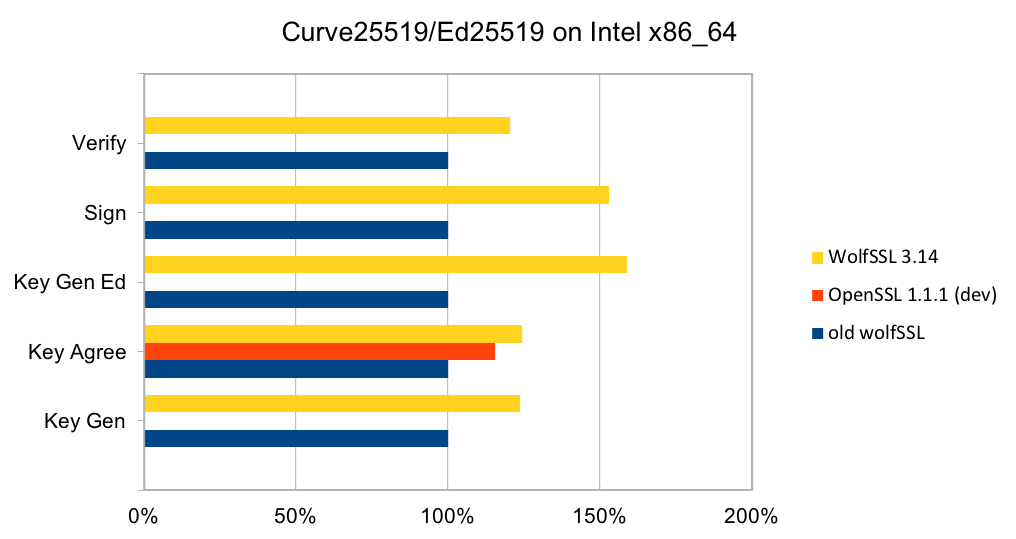
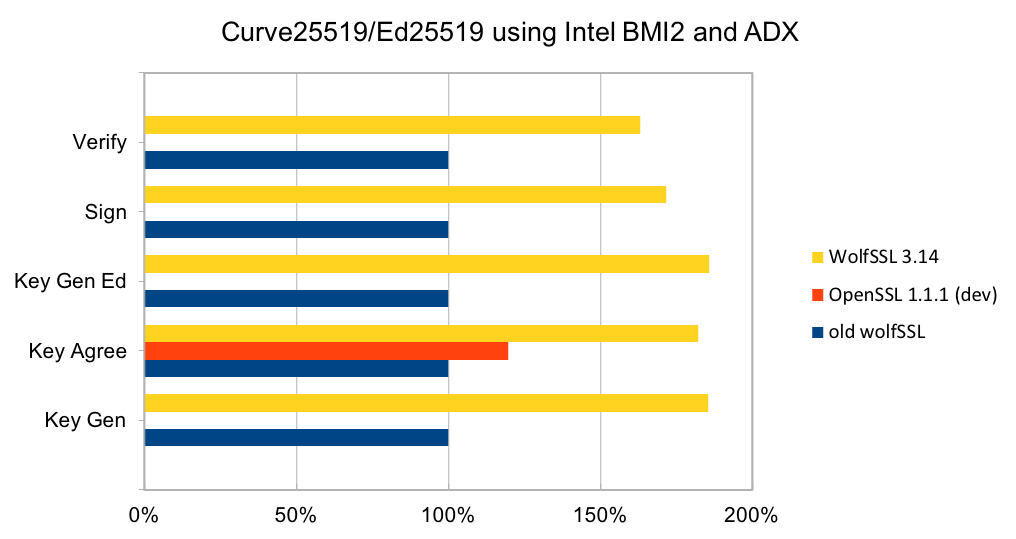
References:
wolfSSL Performance on Intel x86_64 (Part 3)
Recent releases of wolfSSL have included new assembly code targeted at the Intel x86_64 platform. Large performance gains have been made and are being discussed over six blog posts of which this is part 3. In this blog, we will talk about the performance of SHA-256 and SHA-512.
The most commonly used digest algorithms are SHA-256 and SHA-384. With the introduction of AES-GCM in TLS, SHA-256 and SHA-384 are less commonly used for application data authentication. But, they are still used for handshake message authentication, as a one-way function (as required in a pseudo-random number generator) and digital signatures.
The assembly code has been rewritten to take best advantage of the AVX1 and AVX2 instructions. The performance of SHA-256 and SHA-512 is now as good or better than OpenSSL. The four charts below show the performance of wolfSSL has significantly improved from small up to big block sizes. On AVX1, the performance has increased by between 19% and 60% for SHA-256 and between 25% and 53%. Similarly, on AVX2, the improvement has increased by between 22% and 40% for SHA-256 and between 23% and 37% for SHA-512. The new wolfSSL assembly code is also significantly better than OpenSSL for small blocks and is about the same at the largest block size. SHA-384 uses the same algorithm as SHA-512 and therefore has the same underlying implementation and thus the same performance improvements.
Please contact us at support@wolfssl.com with any questions about the performance of the wolfSSL embedded TLS library.
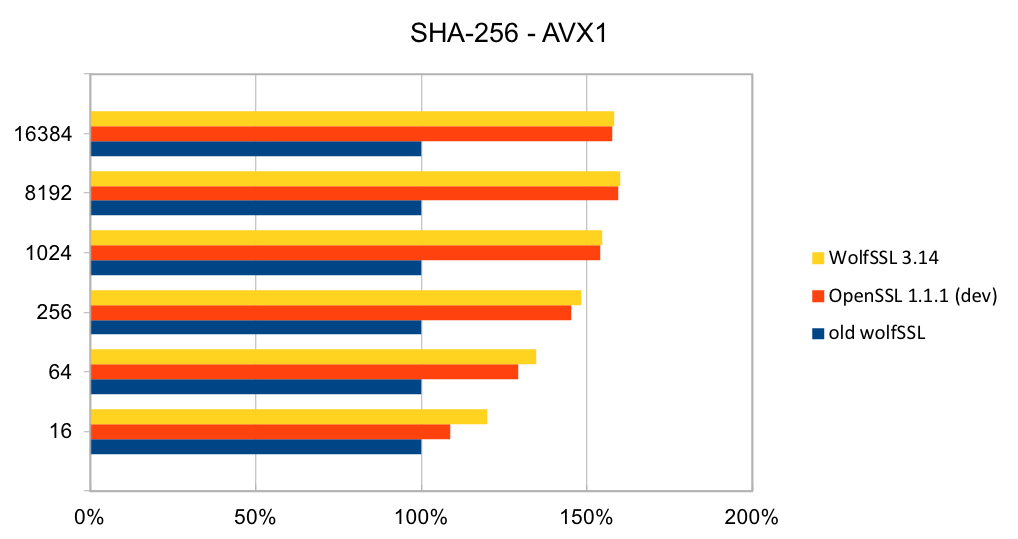
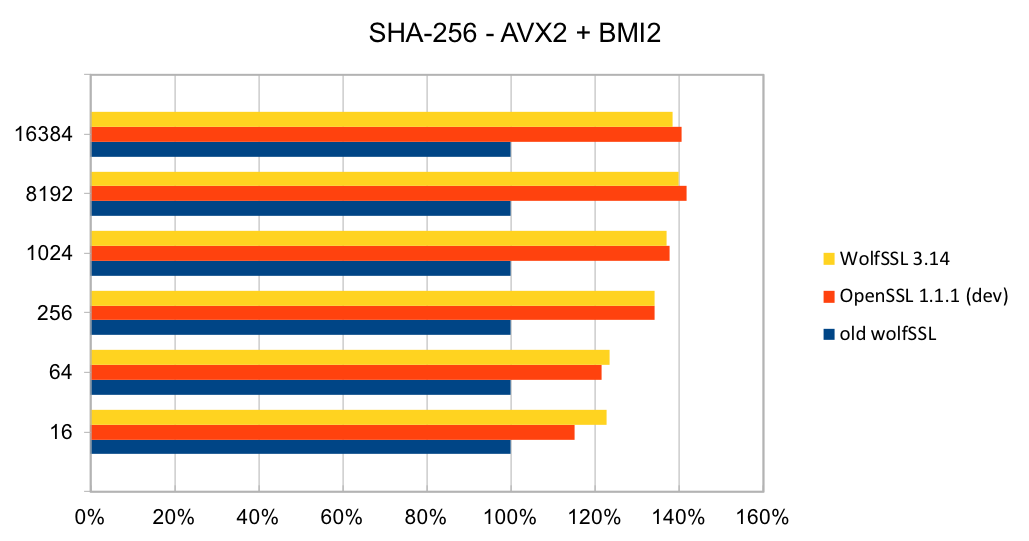
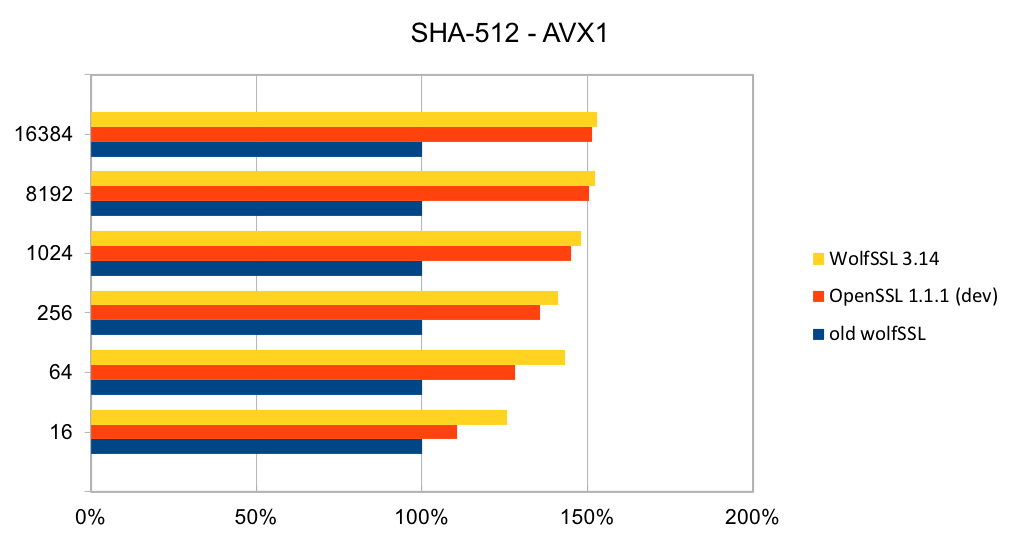

References:
Introduction to Intel® Advanced Vector Extensions
Advanced Vector Extensions (Wikipedia)
wolfSSL Performance on Intel x86_64 (Part 2)
Recent releases of wolfSSL have included new assembly code targeted at the Intel x86_64 platform. Large performance gains have been made and are being discussed over six blog posts of which this is part 2. In this blog, we will talk about the performance of ChaCha20-Poly1305.
ChaCha20-Poly1305 is a relatively new authenticated encryption algorithm. It was designed as an alternative to AES-GCM. The algorithm is simple and fast on CPUs that do not have hardware acceleration for AES and GCM.
Older releases of wolfSSL did not have assembly code implementations of ChaCh20 or Poly1305. So, adding assembly code that uses AVX1 and AVX2 instructions has made a significant difference. The two charts below show the performance of wolfSSL with respect to OpenSSL on AVX1 and AVX2 chipsets. In both charts, the new assembly code is a clear improvement over the C code. Compared to OpenSSL, wolfSSL is between 2.5% and 23% faster on AVX1 and on AVX2 they are the same speed to wolfSSL being 16% faster!
If you have questions about the performance of the wolfSSL embedded TLS library, please contact us at support@wolfssl.com!
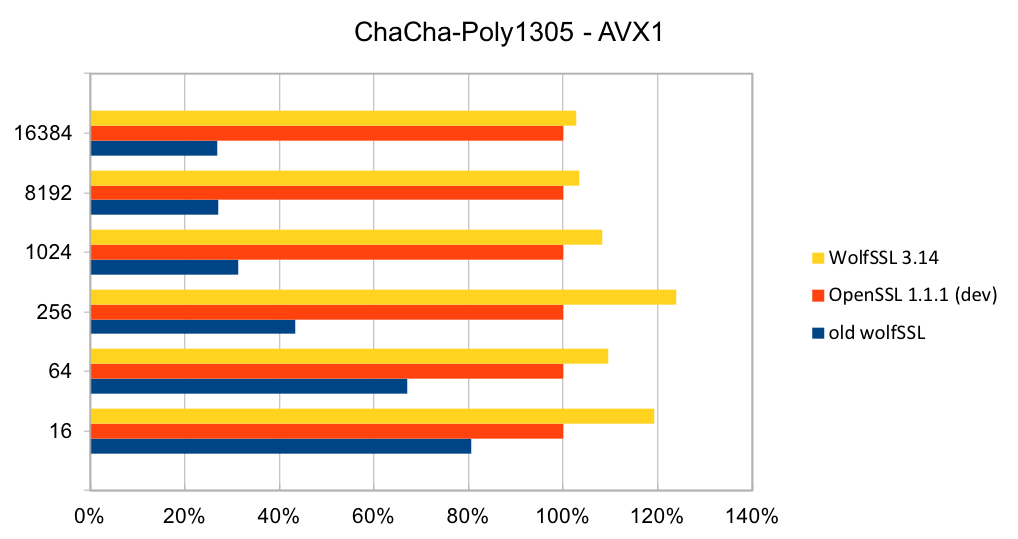
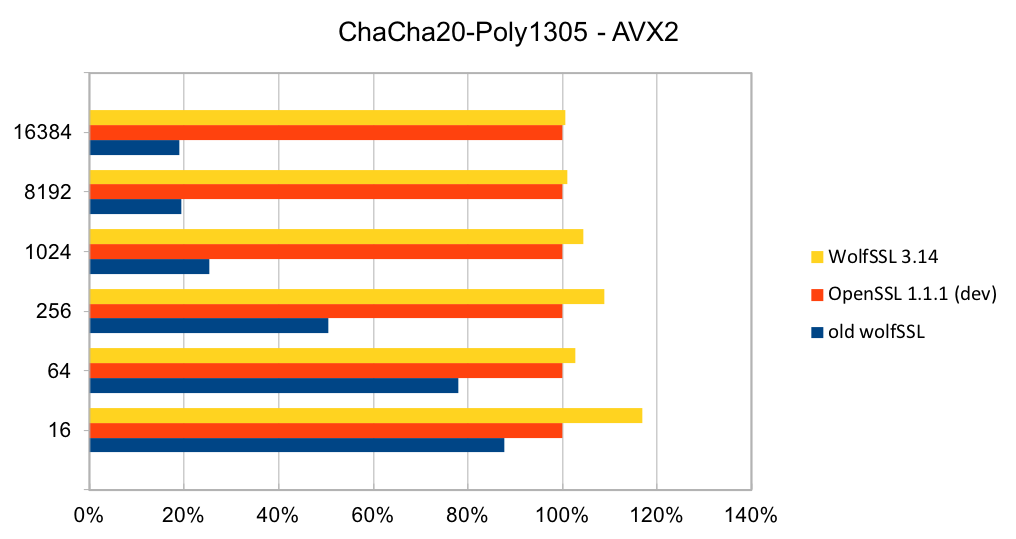
References:
wolfSSL Performance on Intel x86_64 (Part 1)
Recent releases of wolfSSL have included new assembly code targeted at the Intel x86_64 platform. Large performance gains have been made which are being discussed over a six blog post series. In this first blog, we will talk about the performance of AES-GCM.
The assembly code for AES-GCM has been rewritten to take best advantage of the AVX1 and AVX2 instructions. The performance of AES-GCM is now as good or better than OpenSSL.
The two charts below show the relative performance of AES-128-GCM encryption on an Intel AVX1 and AVX2 chipsets. They compare the performance of wolfSSL and OpenSSL with an older version of wolfSSL (before the assembly code changes).
Small block size performance is important when dealing with locally stored data like keys or data in a database. Meanwhile, large block size performance is important for large data transfers in TLS.
The performance of wolfSSL has significantly improved from small up to big block sizes. On AVX1, the smallest block size performance has increased by over 130% and at the top end, there is a 42% improvement. Similarly, on AVX2, the improvement is over 150% for small block sizes to 11% for large block sizes. The new wolfSSL assembly code is also significantly better than OpenSSL for small blocks and is about the same at the largest block size. Similar performance improvements have been achieved for AES-256-GCM as well.
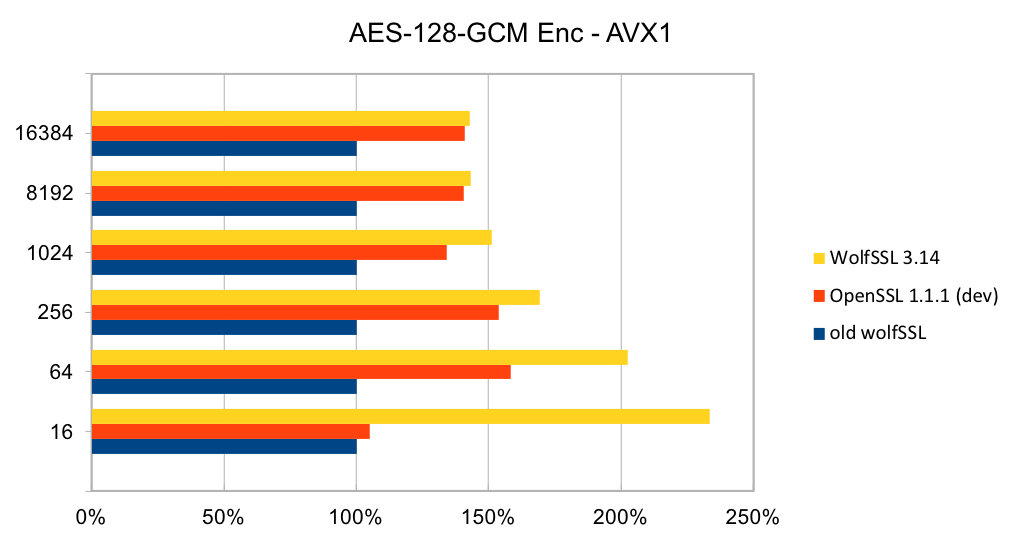
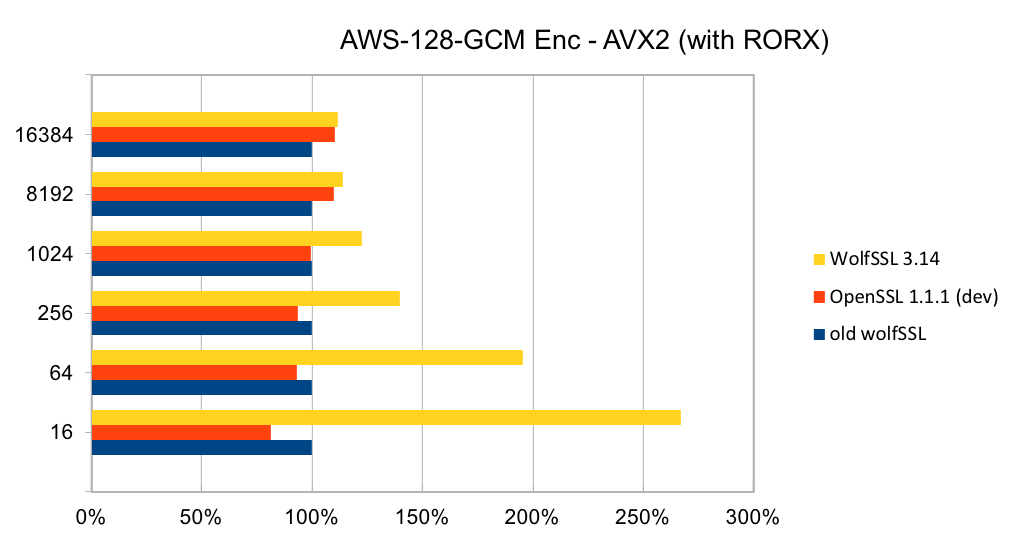
If you have questions about using the wolfSSL embedded TLS library on your platform, or about performance optimization of the library, contact us at support@wolfssl.com.
References:
Introduction to Intel® Advanced Vector Extensions
Advanced Vector Extensions (Wikipedia)
wolfCrypt v4.0 is on the CMVP Implementation Under-Test List (#TLS13)
We are excited to announce that wolfCrypt v4.0 is currently in process for CMVP validation for FIPS 140-2!
We are adding more algorithms to our security boundary including ECDSA, ECDHE, AES-GCM, AES-CCM, SHA-3, and RSA-PSS. Also included is FIPS 186-4 compliant key generation for both RSA and ECC. We will be able to offer TLSv1.3 with FIPS-validated cryptography for embedded TLS and embedded IoT devices!
For more information about our upcoming wolfCrypt v4.0 FIPS validation or about the wolfSSL embedded TLS library, please email fips@wolfssl.com.
AES CFB and XTS
Two modes of AES have been added to the embedded TLS library wolfSSL; AES-CFB and AES-XTS.
AES CFB (Cipher FeedBack) mode is a stream cipher mode of AES. For the first 16 bytes it encrypts an IV using AES and xor’s the result with the plain text for encryption or the cipher text for decryption. For getting the rest of the output the previous 16 bytes is encrypted with AES then xor’d with either the plain text or the cipher text.
AES XTS (XEX encryption with Tweak and ciphertext Stealing) mode is also a stream cipher mode. It is used for disk encryption and has an xor encrypt xor model with a Galois field multiplication for counter. When the input is not a multiple of AES block size (16 bytes), stealing is done to fill out the input size to a complete AES block size. This is done by copying over from the last full AES block size produced.
Both of these modes can be used in IoT applications and take advantage of existing AES hardware acceleration supported by wolfSSL.
For more information about AES modes in wolfSSL contact facts@wolfssl.com.
wolfSSL SGX Updates (Including FIPS!)
wolfSSL is pleased to announce we are in the process of adding FIPS + SGX to our FIPS certificate!
We have updated our SGX-Linux support and are working on adding an example client and server to the existing SGX-Windows project for a complete solution.
If you are working with SGX and need FIPS validated crypto running in an Enclave contact us at fips@wolfssl.com or support@wolfssl.com with any questions. We would love the opportunity to field your questions and hear about your project!
Job Posting: Embedded Systems Software Engineer
wolfSSL is a growing company looking to add a top notch embedded systems software engineer to our organization. wolfSSL develops, markets and sells the leading Open Source embedded SSL/TLS protocol implementation, wolfSSL. Our users are primarily building devices or applications that need security. Other products include wolfCrypt embedded cryptography engine, wolfMQTT client library, and wolfSSH.
Job Description:
Currently, we are seeking to add a senior level C software engineer with 5-10 years experience interested in a fun company with tremendous upside. Backgrounds that are useful to our team include networking, security, and hardware optimizations. Assembly experience is a plus. Experience with encryption software is a plus. RTOS experience is a plus. Experience with hardware-based cryptography is a plus.
Operating environments of particular interest to us include Linux, Windows, Embedded Linux and RTOS varieties (VxWorks, QNX, ThreadX, uC/OS, MQX, FreeRTOS, etc). Experience with mobile environments such as Android and iOS is also a plus, but not required.
Location is flexible. For the right candidate, we’re open to this individual working from virtually any location.
How To Apply
To apply or discuss, please send your resume and cover letter to facts@wolfssl.com.
SHA-3 Support in wolfSSL #TLS13
We’ve fully added support for SHA-3 to the wolfSSL embedded TLS library. We have also included SHA-3 support to HMAC and HKDF. Our SHA-3 offering includes 224, 256, 384, and 512-bit digests. It is tied into our hashing and signature infrastructure, so it will be available to TLS v1.2 or TLS v1.3 when the IETF adds cipher suites using SHA-3. There are also two build flavors to trade between size and speed, good for large server environments and for small embedded applications. If you are a FIPS user, we shall have SHA-3 available inside of our FIPS boundary later this year.
For more information please email us at facts@wolfssl.com.
Nginx with wolfSSL #TLS13
At wolfSSL, we are dedicated to 3rd party integration and have been improving our support for Nginx. wolfSSL now has tested patches for Nginx 1.13.8, 1.12.2 and other point releases.
Nginx builds with OpenSSL by default and this makes getting FIPS 140-2 compliance difficult. Compiling Nginx with wolfSSL is simple and we can help you through the validation process for your platform.
No code changes to Nginx are required for FIPS but make sure your configuration is set appropriately. This includes using:
- RSA with keys of 2048-bits or more
- ECC with P-256 or P-384
- Key exchange with (EC) Diffie-Hellman ephemeral over static
- Ciphers AES-128 or AES-256 in GCM over CBC mode
- Digest and MAC with SHA-256 or SHA-384
The recommended cipher suites are:
- ECDHE-ECDSA-AES128-GCM-SHA256
- ECDHE-RSA-AES128-GCM-SHA256
- DHE-RSA-AES128-GCM-SHA256
Nginx has enabled support for TLS 1.3 and this is also available with wolfSSL. Note that the new draft revision of SP 800-52 requires, for government-only applications, the use of TLS v1.2 and should be configured to use TLS v1.3. wolfSSL has been implementing the TLS v1.3 drafts and performed interoperability testing. We are on track to support the final release of the TLS v1.3 specification.
Weekly updates
Archives
- July 2025 (8)
- June 2025 (22)
- May 2025 (25)
- April 2025 (24)
- March 2025 (22)
- February 2025 (21)
- January 2025 (23)
- December 2024 (22)
- November 2024 (29)
- October 2024 (18)
- September 2024 (21)
- August 2024 (24)
- July 2024 (27)
- June 2024 (22)
- May 2024 (28)
- April 2024 (29)
- March 2024 (21)
- February 2024 (18)
- January 2024 (21)
- December 2023 (20)
- November 2023 (20)
- October 2023 (23)
- September 2023 (17)
- August 2023 (25)
- July 2023 (39)
- June 2023 (13)
- May 2023 (11)
- April 2023 (6)
- March 2023 (23)
- February 2023 (7)
- January 2023 (7)
- December 2022 (15)
- November 2022 (11)
- October 2022 (8)
- September 2022 (7)
- August 2022 (12)
- July 2022 (7)
- June 2022 (14)
- May 2022 (10)
- April 2022 (11)
- March 2022 (12)
- February 2022 (22)
- January 2022 (12)
- December 2021 (13)
- November 2021 (27)
- October 2021 (11)
- September 2021 (14)
- August 2021 (10)
- July 2021 (16)
- June 2021 (13)
- May 2021 (9)
- April 2021 (13)
- March 2021 (24)
- February 2021 (22)
- January 2021 (18)
- December 2020 (19)
- November 2020 (11)
- October 2020 (3)
- September 2020 (20)
- August 2020 (11)
- July 2020 (7)
- June 2020 (14)
- May 2020 (13)
- April 2020 (14)
- March 2020 (4)
- February 2020 (21)
- January 2020 (18)
- December 2019 (7)
- November 2019 (16)
- October 2019 (14)
- September 2019 (18)
- August 2019 (16)
- July 2019 (8)
- June 2019 (9)
- May 2019 (28)
- April 2019 (27)
- March 2019 (15)
- February 2019 (10)
- January 2019 (16)
- December 2018 (24)
- November 2018 (9)
- October 2018 (15)
- September 2018 (15)
- August 2018 (5)
- July 2018 (15)
- June 2018 (29)
- May 2018 (12)
- April 2018 (6)
- March 2018 (18)
- February 2018 (6)
- January 2018 (11)
- December 2017 (5)
- November 2017 (12)
- October 2017 (5)
- September 2017 (7)
- August 2017 (6)
- July 2017 (11)
- June 2017 (7)
- May 2017 (9)
- April 2017 (5)
- March 2017 (6)
- January 2017 (8)
- December 2016 (2)
- November 2016 (1)
- October 2016 (15)
- September 2016 (6)
- August 2016 (5)
- July 2016 (4)
- June 2016 (9)
- May 2016 (4)
- April 2016 (4)
- March 2016 (4)
- February 2016 (9)
- January 2016 (6)
- December 2015 (4)
- November 2015 (6)
- October 2015 (5)
- September 2015 (5)
- August 2015 (8)
- July 2015 (7)
- June 2015 (9)
- May 2015 (1)
- April 2015 (4)
- March 2015 (12)
- January 2015 (4)
- December 2014 (6)
- November 2014 (3)
- October 2014 (1)
- September 2014 (11)
- August 2014 (5)
- July 2014 (9)
- June 2014 (10)
- May 2014 (5)
- April 2014 (9)
- February 2014 (3)
- January 2014 (5)
- December 2013 (7)
- November 2013 (4)
- October 2013 (7)
- September 2013 (3)
- August 2013 (9)
- July 2013 (7)
- June 2013 (4)
- May 2013 (7)
- April 2013 (4)
- March 2013 (2)
- February 2013 (3)
- January 2013 (8)
- December 2012 (12)
- November 2012 (5)
- October 2012 (7)
- September 2012 (3)
- August 2012 (6)
- July 2012 (4)
- June 2012 (3)
- May 2012 (4)
- April 2012 (6)
- March 2012 (2)
- February 2012 (5)
- January 2012 (7)
- December 2011 (5)
- November 2011 (7)
- October 2011 (5)
- September 2011 (6)
- August 2011 (5)
- July 2011 (2)
- June 2011 (7)
- May 2011 (11)
- April 2011 (4)
- March 2011 (12)
- February 2011 (7)
- January 2011 (11)
- December 2010 (17)
- November 2010 (12)
- October 2010 (11)
- September 2010 (9)
- August 2010 (20)
- July 2010 (12)
- June 2010 (7)
- May 2010 (1)
- January 2010 (2)
- November 2009 (2)
- October 2009 (1)
- September 2009 (1)
- May 2009 (1)
- February 2009 (1)
- January 2009 (1)
- December 2008 (1)

